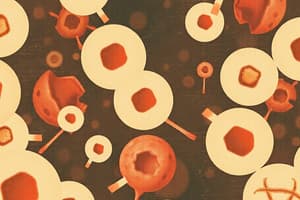Podcast
Questions and Answers
What is the normal range for white blood cell (WBC) count in a healthy individual?
What is the normal range for white blood cell (WBC) count in a healthy individual?
- 1000 – 3000 /cmm
- 15,000 – 20,000 /cmm
- 4000 – 10,000 /cmm (correct)
- 10,000 – 15,000 /cmm
What condition is characterized by having a WBC count below 3000 /cmm?
What condition is characterized by having a WBC count below 3000 /cmm?
- Thrombocytopenia
- Leukocytosis
- Leukocytopenia (correct)
- Erythrocytosis
What is one of the primary functions of platelets in the blood?
What is one of the primary functions of platelets in the blood?
- Facilitate immune responses
- Transport oxygen
- Aid in the formation of new blood cells
- Help stop bleeding in damaged vessels (correct)
What percentage of the total white blood cell count is typically found in the blood?
What percentage of the total white blood cell count is typically found in the blood?
Which types of hematopoiesis are responsible for the formation of white blood cells?
Which types of hematopoiesis are responsible for the formation of white blood cells?
Flashcards are hidden until you start studying
Study Notes
Lifespan and Distribution of White Blood Cells (WBCs)
- WBC lifespan varies from days to months to years.
- Normal WBC distribution: 2% in blood, 98% in lymphatic fluid, organs (skin, lungs, spleen, lymph nodes).
- Tissues exposed to toxins/microbes exhibit variable WBC levels (e.g., skin, mucous membranes).
- Normal WBC count: 4000 – 10,000 cells per mm³ of blood.
- RBC to WBC ratio is approximately 700:1.
- Abnormal WBC counts:
- Leukocytosis: Over 10,000 per mm³ (high WBC count).
- Leukocytopenia: Below 3000 per mm³ (low WBC count).
Platelet Characteristics and Function
- Platelets are cytoplasmic fragments of megakaryocytes, without a nucleus but contain mitochondria.
- Platelets have two types of granules:
- Alpha granules: Contain fibrinogen, thrombospondin, and clotting factors.
- Dense granules: Contain calcium, serotonin, ADP, and ATP.
- Platelet shapes:
- Stimulated form: Discoid shape (2-4 µm).
- Unstimulated state: Spiny spherical shape.
- Function: Essential to stop bleeding in damaged vessels.
Hematopoiesis Overview
- Hematopoiesis: Process of blood cell formation, originates from Greek "haima" (blood) and "poiein" (to make).
- Average adult bone marrow produces approximately 5 x 10¹¹ cells daily.
- Controlled and balanced production of blood cells.
- Types of hematopoiesis:
- Erythropoiesis: Formation of red blood cells (RBCs).
- Leukopoiesis: Formation of WBCs, includes:
- Myelopoiesis: Formation of granulocytes and monocytes.
- Lymphopoiesis: Formation of lymphocytes.
- Thrombopoiesis: Formation of platelets.
Embryonic Hematopoiesis
- Hematopoiesis starts in the yolk sac during the first month of embryogenesis and shifts to the liver and spleen.
Erythropoietin Mechanism
- Normal blood oxygen levels are essential.
- Hypoxia (low O2): Triggers erythropoietin release from kidneys (also from liver) to stimulate RBC production.
- Increases RBC count, enhancing oxygen-carrying ability of blood.
Leukocyte Classification
- Leukocytes are complete cells classified by:
- Cytoplasmic granulation:
- Granulocytes: Neutrophils, eosinophils, basophils.
- Agranulocytes: Monocytes, lymphocytes.
- Function:
- Phagocytes: Granulocytes and monocytes.
- Non-phagocytes: Lymphocytes.
- Cytoplasmic granulation:
Granulocyte Characteristics
- Neutrophils account for 40-80% of total WBCs, possess granules that stain with acidic and basic dyes, appearing pink-blue or gray-blue.
Leukopoiesis Regulation
- Leukopoiesis is hormonally induced by cytokines: interleukins (numbered like IL-1, IL-2) and colony-stimulating factors (CSFs).
- Key sources of cytokines: macrophages and T cells.
- Hematopoietic hormones are clinically used to stimulate bone marrow.
Control of Granulopoiesis
- Growth factors involved in granulocyte maturation include IL-1, IL-3, IL-5 (for eosinophils), IL-6, IL-11, GM-CSF, G-CSF, and M-CSF.
- These factors promote proliferation and differentiation of granulocyte precursors.
Platelet Production Process
- Platelets produced by fragmentation of megakaryocyte cytoplasm in bone marrow.
- Megakaryocytes arise from hematopoietic stem cells and undergo endomitotic synchronous replication.
- Each megakaryocyte produces 1000-5000 platelets; the process takes about 10 days.
- Normal platelet count ranges from 150-400 x 10⁹/L; lifespan is 7-10 days.
- Approximately one-third of platelets may be stored in the spleen, increasing to 90% during massive splenomegaly.
Studying That Suits You
Use AI to generate personalized quizzes and flashcards to suit your learning preferences.




